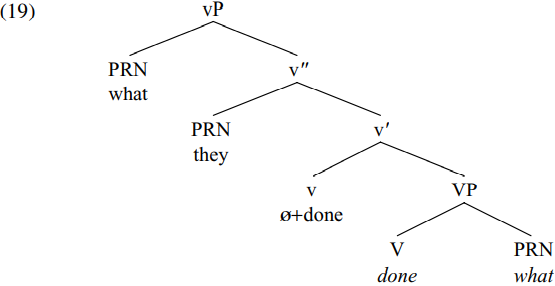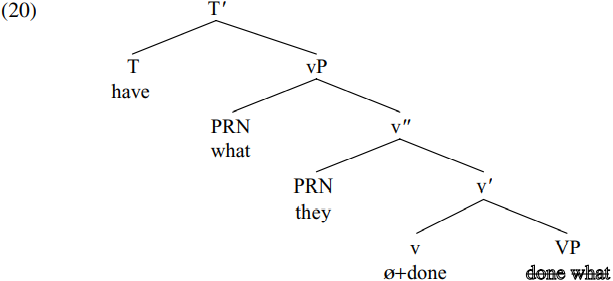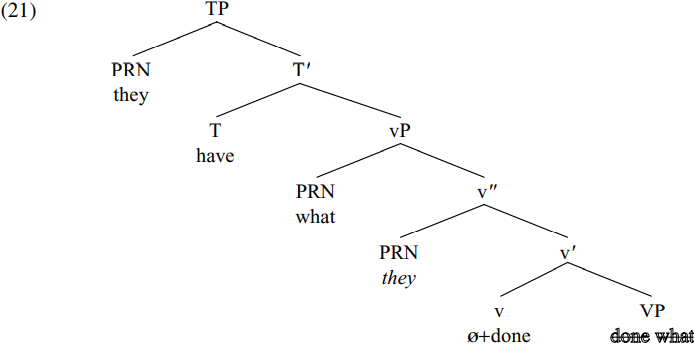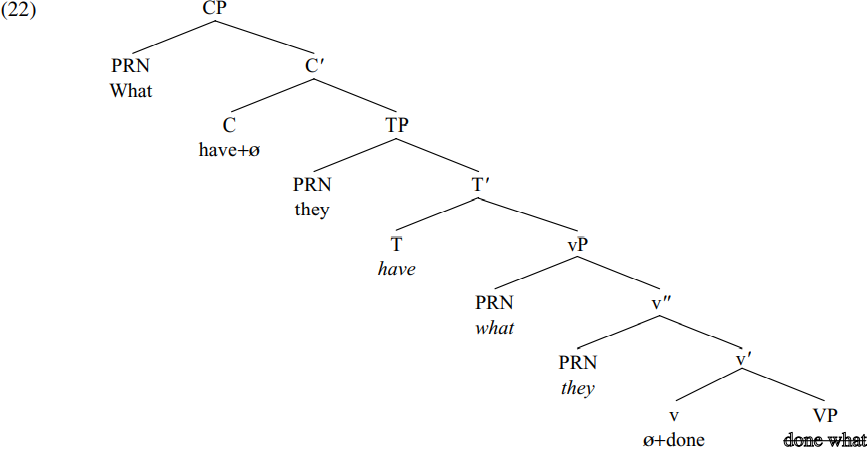
Wh-movement through spec-vP in transitive clauses
 المؤلف:
Andrew Radford
المؤلف:
Andrew Radford
 المصدر:
Minimalist Syntax
المصدر:
Minimalist Syntax
 الجزء والصفحة:
391-10
الجزء والصفحة:
391-10
 2023-02-17
2023-02-17
 1859
1859
Wh-movement through spec-vP in transitive clauses
Our discussion showed that the assumption that CPs are phases means that long-distance wh-movement requires successive-cyclic movement of a moved wh-expression through intermediate spec-CP positions. However, since transitive vPs are also phases, it follows that in structures containing one or more transitive vPs, wh-movement will have to pass through intermediate spec-vP positions as well (since transitive vPs are phases). We can illustrate how this works in terms of the following example:

(18) will be derived as follows. The verb DO (shown here in its spellout form done) merges with its thematic complement what to form the VP done what. This is merged with a transitive light verb whose external argument is they and which (by virtue of being affixal) triggers raising of done from V to v; the light verb (by virtue of being transitive) also values the case feature of what as accusative and (by virtue of being  -complete) deletes it. Let’s suppose that just as C can have an [EPP] feature attracting movement of a wh-expression, so too a transitive light-verb (perhaps by virtue of being a phase head, like C) can likewise have a wh-attracting [EPP] feature. This being so, what will be moved to become a second specifier for vP, forming the structure below:
-complete) deletes it. Let’s suppose that just as C can have an [EPP] feature attracting movement of a wh-expression, so too a transitive light-verb (perhaps by virtue of being a phase head, like C) can likewise have a wh-attracting [EPP] feature. This being so, what will be moved to become a second specifier for vP, forming the structure below:

The notational convention assumed in (19) is that first merge of a head H with its complement forms an H-bar/H’ projection; second merge of H with a specifier forms an H-double-bar/H’’ projection; third merge of H with another specifier forms an H-treble-bar/H’’’ projection . . . and so on. However, by tradition, the maximal projection of H is denoted as HP: hence, the node labelled vP in (19) is a v-treble-bar projection, but is labelled vP because it is the maximal projection of the relevant light verb.
The double-specifier analysis in (19) is in accordance with Chomsky’s (1998, p.16) assumption that a head can have multiple specifiers – in the case of (19), an inner specifier they representing the external argument of the light verb, and an outer specifier what which deletes the [EPP]feature of the light verb. In accordance with (7i), the VP in (19) will undergo transfer at the end of the vP phase, and the two italicized traces will thereby be given a null spellout. Of course, if what had not moved to spec-vP at this point, it would have been spelled out in situ and hence frozen in place, and thereby wrongly be predicted to be unable to undergo wh-movement. (Although we adopt Chomsky’s multiple-specifier analysis here, it should be noted that one way of avoiding multiple specifiers would be to assume that light verbs are A-heads like T and hence only allow an argument as their specifier, and that what doesn’t move to become a second specifier of vP, but rather moves to become the specifier of a separate A-bar head above vP – perhaps becoming the specifier of a Focus head. Note that in the terminology of Roberts 1994, a head like T which allows only an argument as its specifier is an A-head, and a head like C which allows either an argument or an adjunct as its specifier is an A-bar head.)
Since a transitive vP is a phase, the VP domain done what in (19) will undergo transfer at the end of the vP cycle, and the trace copies of the moved constituents done and what will each receive a null spellout. The derivation then proceeds by merging [T have] with the vP in (19), forming the T-bar (20) below:

The probe have now searches for an appropriate goal. It needs to ‘skip over’ what and instead identify they as the expression that it agrees with, assigns nominative case to and attracts to move to spec-TP. Clearly we cannot say that what is inactive as a goal since it needs to be an active goal in order to be able to undergo subsequent wh-movement. However, it seems reasonable to suppose that what is active only for agreement with an A-bar head, not for agreement with an A-head. More specifically, we can suppose that a noun or pronoun expression which carries interpretable person/number/gender features is only active for agreement with an A-head if it has an unvalued and undeleted case feature: this would mean that what is ineligible for A-agreement because its case feature was valued as accusative and deleted by the transitive light verb at the earlier stage of derivation shown in (19) above. By contrast, since they in (20) has an unvalued case feature, it is active for A-agreement and A-movement (but not for A-bar movement). Accordingly, have agrees with, assigns nominative case to and triggers movement of the subject they, so deriving:

This TP is then merged with a null complementizer with a strong tense feature (triggering movement of have from T to C) and an [EPP] feature which triggers movement of what to spec-CP, so deriving:

At the end of the CP phase, TP undergoes transfer in accordance with (7i) and the italicized traces are given a null spellout in the phonological component. Subsequently, the constituents at the edge of CP (i.e. its specifier what and its head have+ø) undergo transfer in accordance with (7ii).
Our discussion of the derivation of (18) What have they done? shows us that in transitive clauses A-bar movement will involve movement through spec-vP into spec-CP. An obvious implication of this is that wh-sentences like (23) below which contain two transitive clauses:

will correspondingly involve successive-cyclic wh-movement through two spec-vP positions (and likewise through two spec-CP positions) – as shown in skeletal form below:

More generally, a sentence containing n transitive verbs and m CPs intervening between the initial position of a wh-expression and its ultimate landing site will involve movement through n spec-vP positions and m spec-CP positions.
 الاكثر قراءة في Syntax
الاكثر قراءة في Syntax
 اخر الاخبار
اخر الاخبار
اخبار العتبة العباسية المقدسة


